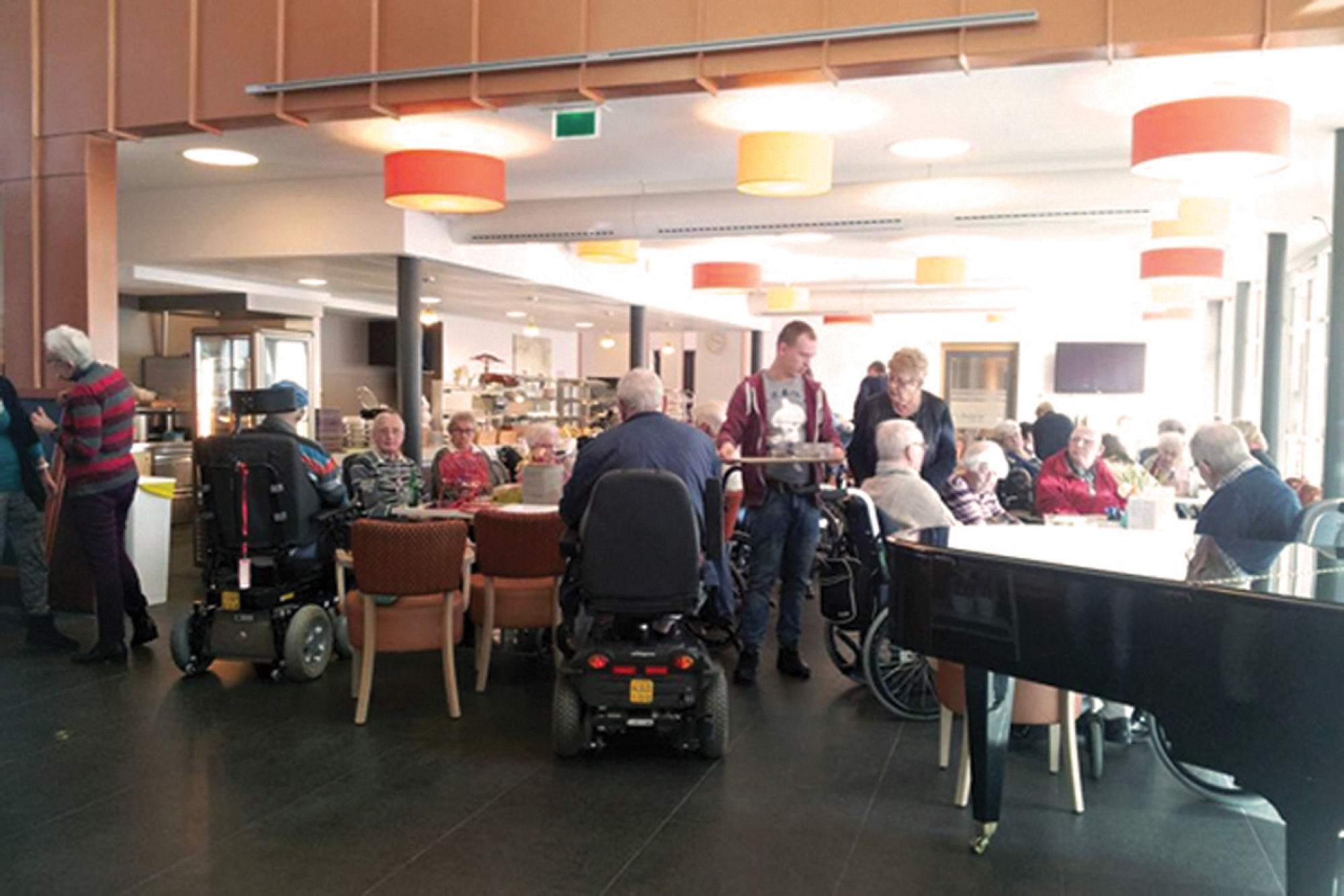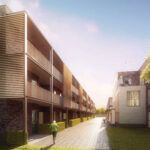Across the globe populations are getting older and as a continent Europe has the most rapidly ageing population. On average people are now living twenty years longer than they did twenty years ago. In response to this trend the members of PERSPECTIVE recently held a workshop in Zoetermeer, Netherlands, on Age-Friendly Environments. The workshop was appropriately held in the Vierstroom Vivaldi 150 bed nursing home designed by PERSPECTIVE Netherlands. The Vierstroom Vivaldi is an exemplary design providing a welcoming, comfortable and homely environment for residents where they have facility to personalise their environment and where the building greatly facilitates interaction in a passive and proactive way with the community. Every detail has been thoroughly considered to support positive ageing. The Perspective Workshop addressed two issues: • Age friendly urban environments: how the living environment can contribute to a longer stay at home? • Age friendly workplace environments: how the working environment can contribute to an extended active working period?
URBAN ENVIRONMENTS
The living city is a city where planning, urban design and architecture combine to generate an environment that integrates living and social activities in harmony with workplace and commercial development, transport and general infrastructure. Too often the design approach is predicated on the capacity of the fit and able-bodied adult and fails to address the wider spectrum of needs and limitations of the general population. Urban design solutions have the potential to optimise inter-generational activity assisting the creation of healthier and socially supportive communities. In mixing age profiles opportunities arise for mutual benefit: younger people assisting older with shopping and gardening, elder persons assisting with caring for children, sharing their wisdom and experience, providing learning support and recounting stories. There are multiple other possibilities for mutual benefit. All people need a supportive environment. For the elderly, the challenge for designers is to go beyond universal access to environments that support social, cultural and employment participation for as long as possible within the community setting. At the Perspective workshop members’ discussion included exploration of different precedents in urban design. The traditional Spanish model of social housing comprising apartments set in multi-storey blocks around large communal courtyards with shared facilities – a swimming pool, hard play areas, seating and garden area designed to suit young and old recreational activities. A football pitch for walking football, a popular all age sport is a central feature. Combining a range of unit sizes from large family to single occupancy units along with meaningful external space potential is generated to foster community engagement and the interaction of residents of all ages with and in support of each other.
It also provides lifelong residential accommodation within a single complex to meet family needs as they expand and contract and supports the building and maintenance of friendships within the community.
The World Health Organisation has identified eight key domains of influence for change in approach to age friendly environments:
• Communication and Information
• Community support & healthcare services
• Employment and civic participation
• Housing
• Outdoor spaces and Buildings
• Respect and social inclusion
• Social participation
• Transport
The regeneration of areas of decline within cities is an opportunity to create good mixed housing integrated within the city fabric. The advantages are obvious in terms of proximity to shops, services and transport. Architectural design must respond by generating bright, light-filled and secure and that foster and support community development, social interaction and inclusion. Particular issues discussed included on-street hall door access which often contributes to isolation, anonymity and mitigates against community engagement. Approaches through shared, semi-public communal spaces were considered to respond to these issues, providing opportunity to enhance engagement, increase security and be generally safer for the elderly. Residents have the opportunity to support each other and generally look out for each other. Awareness of the presence of neighbours and reliance on their vigilance often gives great comfort to the elderly living alone. The inclusion of shared semi-public space for casual encounter and engagement needs to be tempered with ‘defence space’ directly at the apartment door or window. The provision of external space enabling appropriate ‘sport’ and ‘fitness’ for the elderly within the landscape design of the semi-public shared space, for both hard and soft elements, enhances integrated activity. Sheltered sunny terraces overlooking shared and communal areas of activity afford delight to residents of all ages. Other issues include appropriate storage and parking for mobility aids, motorised wheelchairs and buggies. The enhancement of the IT infrastructure of the home offers significant opportunity to discretely increase support to the resident. Alarms which are triggered by sensors when a person falls on the floor, or when a hall door has not been opened for some time are examples of unobtrusive yet supportive infrastructure enabling autonomy.
WORKPLACE ENVIRONMENTS
Adapting to new environments, be that for living or for working is a difficult task for everyone; for the ageing it is particularly challenging. While one can often choose one’s home, this is not the case for the workplace, where settings are predetermined irrespective of age. These environments too often serve to emphasise the diminished capabilities of the older worker, rather than supporting their abilities and enabling benefit flow from this rich resource of experience and skill in the workplace. Time management is also very different for upcoming younger staff than for elderly members of the team. Expectations may become problematic without acceptance of these natural and inherent differences. Good design can significantly contribute to an age-friendly environment where the older worker can be at ease in busy and energetic environments which favour the sharing and redistribution of the experience both in dedicated spaces and unpredicted ways. Large open plan offices with cubicles or bench-desks are not a solution. People are moving more and more in and out and within the office and office design is currently changing to suit new ways of working. Break-out spaces, hot desking, casual seating and spaces for informal knowledge share are rapidly being accepted as a way to optimise the use of expensive real estate and also meet the needs of the younger, IT enabled workers. Perspective architects believe design of age-friendly workplace can be assimilated successfully in a seamless manner into this environment. At our recent workshop discussion, we concluded that what is probably needed is more breakout or common areas arranged like living rooms; a number of “consulting the guru” rooms fitted out with comfortable chairs, warm lighting and hot desks located in a more relaxed setting alongside, or within, soft breakout spaces. Solutions could extend to include clubs or dedicated spaces offered to elderly people known to the business, where they could gather and socialise, interacting with people moving through the office or chat with and mentor staff. The possibilities to create age- friendly work environments are as wide as our imagination and our willingness to embrace this opportunity can extend. All in all, at a social and professional level, interaction between young and old, and the transfer of competences is both stimulating and vital. Workplace design can influence much improved outcomes by offering some ‘slow-spaces’, where furniture, lighting, orientation, easy to operate appliances, amplified telephone or video conferencing equipment, computer screens that allow for visual enhancement and ergonomic keyboard / chairs, are readily available. One may argue that this is of itself discrimination by design, but we are of the opinion that such well designed and considered workspaces will be more accessible and user friendly to the advantage of all and soon become the norm. Interaction between generations will be difficult to achieve as long as designers ignore the potential that can be realised with good considerate and appropriate design at both the urban scale as well as the more intimate workplace environment. Although at present older workers’ experience barriers in relation to Technology and IT, we trust that it will all become much easier as virtual reality becomes ubiquitous at home and at work. Resolution of transportation deficits, often an issue for the elderly may even be partly resolved as the IT industry seeks to generate automated vehicles of all types. The Perspective workshop discussion also touched on the current mass migration of people into Europe and raised the question of giving older people a new social role acting as tutors for the new to-be citizens. 5,000,000 immigrants are expected in Europe by 2020; how will they learn higher skills and become useful for the economic system? Elderly people may have a central role here and the younger may benefit from their assistance



